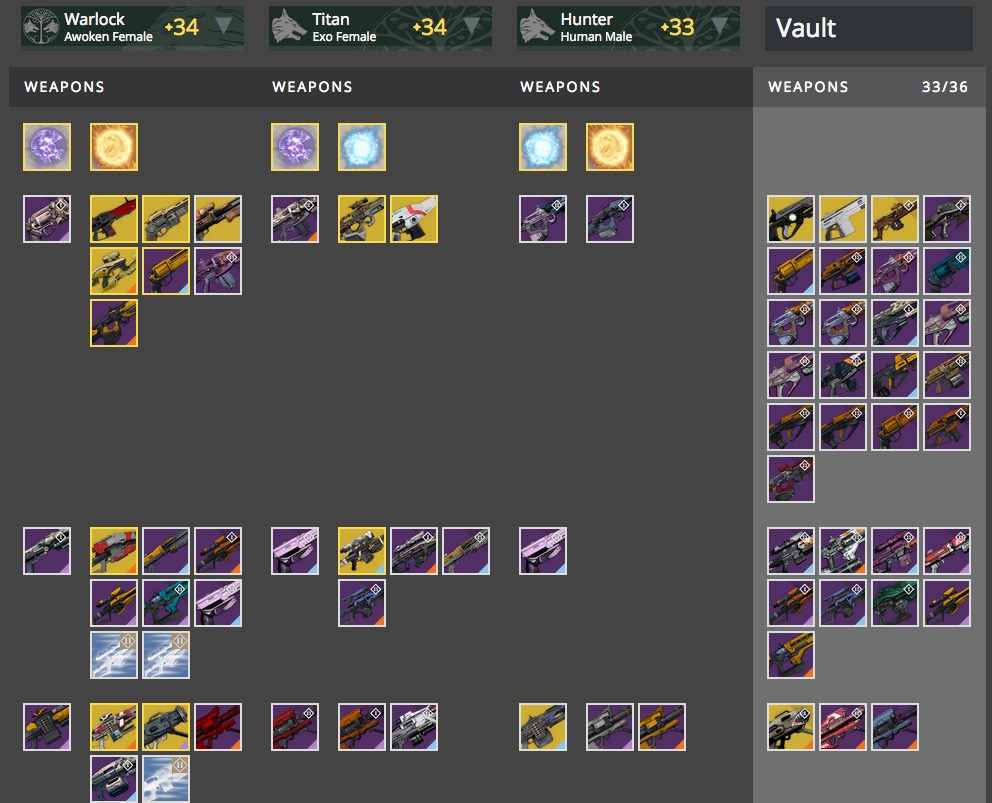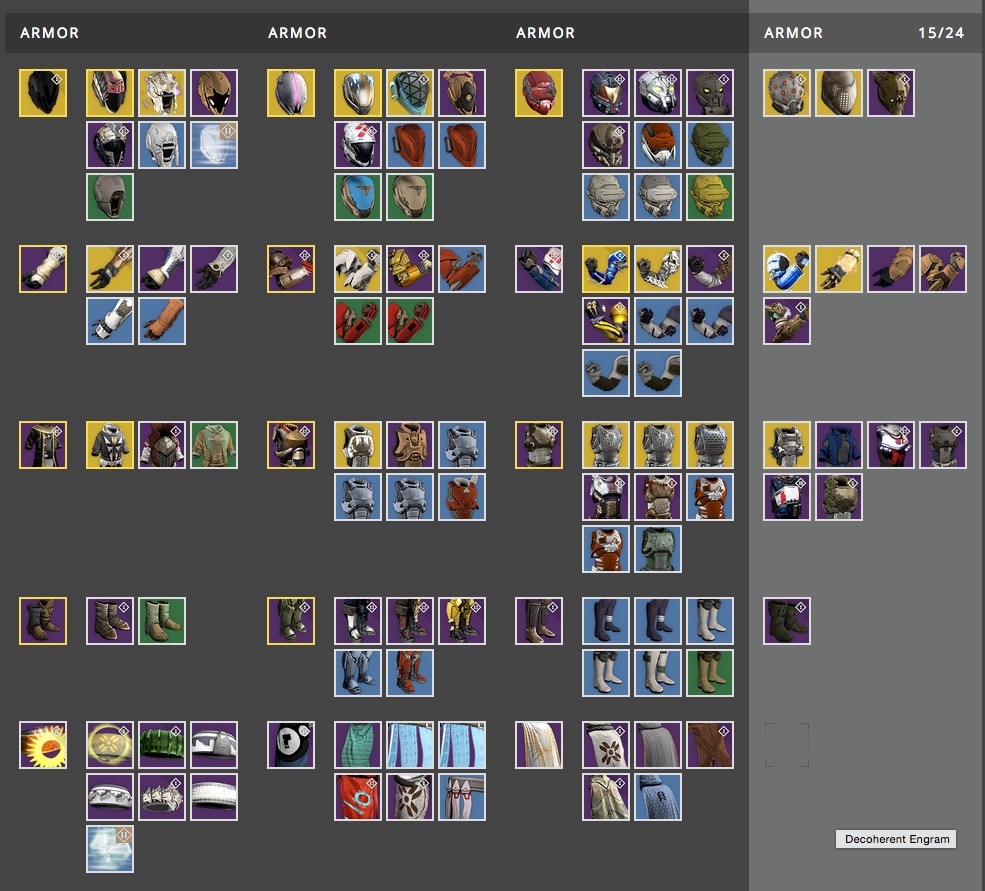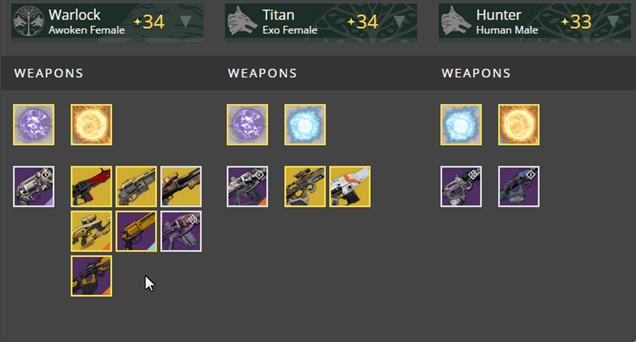If you play a lot of Destiny, chances are you’ve had a hard time keeping track of all your gear. It’s fun to collect rare and exotic weapons and armour, but it can be a headache organising everything. Thankfully, there’s an app for that.
The app is a Chrome extension called Destiny Item Manager (DIM for short). Once you log into your Bungie.net account, DIM lets you easily move weapons, armour, crafting materials, and currency between your various characters with the click of a mouse. If you’re fighting a boss and you need that rocket launcher you left back in your storage vault, you can simply open your laptop, drag it over to your character, and bam! It appears in your inventory.
I’ve been using DIM for the last month or so, and I can’t believe I ever lived without it. To think, we used to go to the tower, drop off all our stuff, then load a new character, go back to the tower, and pick it all up! And if we forgot something? Do it all over again.
Here’s the remarkable thing about DIM: It’s unofficial. Destiny developer Bungie had nothing to do with it. Rather, DIM was created earlier this year by a programmer named Kyle Shay and made available for free to all Destiny players.
“Originally, my brother asked me to create something that was just for equipping loadouts,” Shay told me in an email. “He didn’t care there wasn’t an easy way to move around items — he just wanted to click a button to be ready for Vault of Glass or Iron Banner.”
Shay saw how that could be useful but figured that an even more useful tool would let you move items between one of the three “alt” characters that many Destiny players maintain. “When Bungie made it possible to move items via their API, I knew that it just had to be made,” he told me.

The term API is short for “Application Program Interface.” Basically, an API is a way for one piece of software to talk to another piece of software. When a developer releases their API to the public, outside developers are able to make new software that talks to (and therefore makes use of) the original developer’s software. For example, popular third-party Twitter apps like Tweetdeck use Twitter’s API to put a new interface on top of Twitter’s existing software.
Shay described the process of making DIM as “some reverse engineering of the Bungie website and some crazy long nights prototyping and polishing.” He finally released it on March 4, about a week after it first became possible to do such a thing.
“The hardest part about it was that nothing quite like this had ever been done before, and there was no documentation to boot,” he said. “There was a lot of guessing. The challenge was so much fun.”
DIM works in an ingenious way: It piggybacks on the existing Destiny website, which starting earlier this year let players move around gear from character to character. Thing is, the website only lets you move things one at a time, and can be pretty cumbersome to use. Allowing players to move equipment outside of the game was welcome, but Bungie’s built-in tools needed some work. Bungie’s smartest move, then, wasn’t just making it possible to move items around through a browser, it was opening up their API so that developers like Shay could create their own tools for the job.
“DIM is able to communicate with the Destiny API to discover what items you store on your characters and within the vault,” Shay said. It can “move an item between a character and the vault and equip an item on a character.”
“Our real payment is the joy of working on, and being able to use the tool ourselves!”
Some players are understandably hesitant to give a third party app what feels like access to their precious Destiny guns and armour — what’s to stop Shay from hijacking your account and deleting your Vex Mythoclast? Shay told me that’s an impossibility.
“DIM uses a feature of Chrome Extensions that allows our app to ask permission to use your secured and authenticated Bungie.net cookie to communicate with the Destiny API on your behalf,” he said. “This means that DIM will never come into contact with your username and password, which is a huge concern for users of 3rd party apps. This can be tested by logging out of Bungie.net, which removes your cookies and any ability for DIM to communicate with the Destiny API.”
As for bugs harming your precious gear, Shay offers the following reassurance: “Let me just say that over the past five months, I’ve probably moved more gear through DIM than anyone else in the process of building this app. I have never lost an item. DIM can’t do anything that the Bungie.net website or the official companion app can’t do — most importantly dismantling items. There is currently no possible way to do that outside of the game itself.”
Since unveiling the Destiny Item Manager, Shay has helped run a subreddit dedicated to the app, where he fields technical questions and posts update notes. “DIM is maintained by an excellent group of designers and developers,” Shay said. “One of the major/lead contributors is Rick Casey. He took my original code and broke it out into many organised parts, so it’s easier for a team to work on it at any one time.”
Shay told me Destiny Item Manager is approaching 200,000 active users, with around 5,000 people using it any given hour. He says he’s not planning on charging for DIM or adding ads, but there is a donation button for grateful users. Says Shay: “Our real payment is the joy of working on, and being able to use the tool ourselves!!”

I asked if Shay had heard anything from Bungie about the app. Nothing official, he said. “We’ve heard from individuals that work at Bungie, and they tell us that they use DIM and really enjoy it. That’s about the extent of it.” Shay mentioned how impressed he was with the fact that Bungie made their API public in the first place. “Bungie has always been very supportive of the community of developers that work to make new experiences for players,” he said. “I can’t name many development studios that provide this level of resources, for free.”
As for the future of DIM, Shay says the next step is to make a version for iOS, Android, and Windows Phone, hopefully by the end of June. “There is a lot of work to be done,” he said, “and we want it done right. At this point, it is mostly a user experience challenge more so than it is technical to handle so many items on such a small screen.”
There are some competitors for DIM out there, including Bungie’s own official Destiny app and the well-made smartphone app Loadouts for Destiny, which is certainly nice to use in lieu of leaving a laptop open next to your TV as you play. Still, given how often I’m moving individual crafting materials or various currencies around to navigate Destiny‘s hilariously obtuse and convoluted economy, I can’t imagine there’ll ever be a substitute for the big-picture, drag-and-drop usability of a browser extension like Shay’s.
I’m continually impressed with the industriousness of Destiny players. If I’m stuck on a difficult encounter or curious how best to use a new piece of gear, it’s a safe bet that other players have already helpfully documented the best way to proceed. If I need to take care of some public events, I can use the peerless Destiny Public Events Tracker to easily find one. And if I’m stuck without teammates to play with, Destiny‘s popular player-run Looking For Group (LFG) sites make it a cinch to find other players to fill out your co-op teams.
Destiny Item Manager, and the other apps like it, are just more examples of the Destiny community in action. Bungie’s decision to make their API public is a welcome demonstration of faith in their community, not entirely unlike PC developers who open their games up to modders. For all that we may knock Bungie for their frequent lack of communication around Destiny in general, it’s nice to see that they trusted their players to come up with creative ways to make it better. Now if only the Item Manager could somehow conjure that Hawkmoon I’ve had my eye on…

Comments
10 responses to “One Of Destiny’s Most Useful Tools Wasn’t Made By Bungie”
Plot twist, Tower Ghost is better and it already has an iOS and Android app.
Eh, they’re mostly the same. I prefer DIM for the drag’n’drop feature alone. Occasionally use DTG to move partial stacks, or check more detailed item info, but the android app just doesn’t log in half the time, so it’s usually easier to just go to my PC and use DIM if I just want to move stuff around. Either is pretty much a must have, tho – I have one empty spot in the vault just so I can move stuff around.
I don’t even play Destiny anymore (maybe I’ll return) but damn that is a great tool.
Been transferring my items between vault and characters with the official companion app, works great for this guy who only has a single exotic armour piece for both my characters LoL. Maybe I’d see the use of another Destiny app if I had bazillions of crazy gear, as it stands though the official app works a treat *shrug*
I use this a lot and damn it is good. Never had any issues with it. Didnt know I could donate, might go back and shout the guy lunch. What a champ.
So I’ve gotten back into playing this and last night hit light level 24. Is there some benefit to having other characters?
To experience the other classes, which play differently thanks to different abilities. Other than that, more chances for loot since you can do the daily/weekly heroics and Nightfalls 3 times instead of once, etc.
Yes and no. It all depends on how much time you have.
PROS:
1. With other characters you can do 3 times the activities, so three chances at loot from nightfalls, raids etc.
2. The base mechanics (shooting ) are the same for all characters but you get to experience different supers and generally different playstyles. The Titan is a tank, hunters are more agile etc.
3. More resources- with three characters you can have more strange coins, weapon parts, motes of light etc.
4. Extra characters kind of improve your vault space. If you don’t really play with your secondary characters you can use them as pack mules and store extra weapons and armour
CONS:
1. 3 characters are kind of a time sink.
2. doing stuff 3 times every week will just highlight how repetitive Destiny’s content is.
3. You run out of glimmer and materials regularly since you’re upgrading 3 times the armour.
Here’s the thing – I found the story missions to be a horrible waste of time – always go through these dark corridors, no re spawning, bosses that are next to impossible – but patrols, public events and the crucible are lots of fun. If I could somehow unlock the planets while doing the bare minimum with the story it would be great
Are Vanguard/Crucible marks character specific or can they be shared also?
Vanguard and crucible marks are character specific. 200 marks are the max for each. (You can earn 100 marks per week)
You can’t unlock planets without doing the story missions but you can get a higher level friend to just help you quickly rush through them. Also once you get to level 4 you’ll unlock the crucible and bounties, so you can skip the story entirely and just level up using bounties and playing crucible. Then once you are high level just go back to the story missions and quickly beat the previously hard bosses. You just want to unlock the planets so you can do more bounties. Many of the bounties can be done on patrol but others require you to beat bosses on specific planets etc.